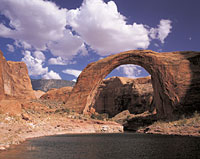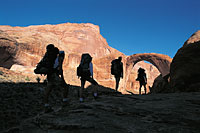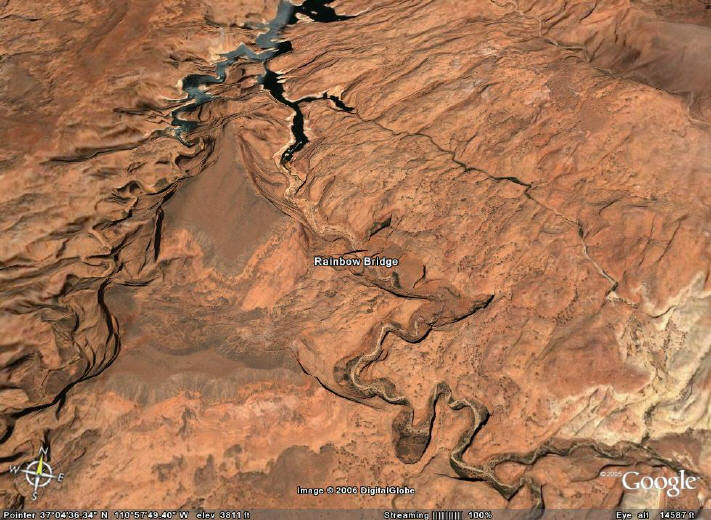Rainbow Bridge National
Monument - Lake Powell, Utah
Rainbow Bridge has deep
religious and spiritual significance to area Native American tribes. It is called "Nonnezoshi" by the
Navajo people, or the "rainbow turned to stone." Special
prayers are offered before passing beneath the bridge and
failure to do so is believed to bring misfortune. In 1995,
the Nation Park Service began requesting that visitors
refrain from passing under the monument in an effort to
respect the longstanding beliefs of the Native American
people.
Native American tribes. It is called "Nonnezoshi" by the
Navajo people, or the "rainbow turned to stone." Special
prayers are offered before passing beneath the bridge and
failure to do so is believed to bring misfortune. In 1995,
the Nation Park Service began requesting that visitors
refrain from passing under the monument in an effort to
respect the longstanding beliefs of the Native American
people.
By far the most popular
destination on Lake Powell, Rainbow Bridge stands
approximately 290 feet high creating an awe-inspiring sight.
It is made of Navajo Sandstone at the top and Kayenta
Sandstone at the base and was formed when the drainage in
the stream bed broke through to the other side of a meander
creating an ever widening hole in the ancient cliff face. In
1910, the geological significance of the monument caught the
attention of the public and the site was named a national
monument by President William Taft. The largest natural
bridge on earth, Rainbow Bridge is one of the seven natural
wonders of the world.
 Boat
and air tours are offered daily throughout most of the
summer season. Visitors in private and rental boats may also
use the courtesy dock at the monument, and then walk less
than a mile along improved trail to the viewing area. A
portion of the trail to the first viewing area is accessible
to most wheel chairs. Boat
and air tours are offered daily throughout most of the
summer season. Visitors in private and rental boats may also
use the courtesy dock at the monument, and then walk less
than a mile along improved trail to the viewing area. A
portion of the trail to the first viewing area is accessible
to most wheel chairs.
Organized tours welcome
special needs passengers, however, advance notice is
requested. National Park Service Rangers are on hand to
answer questions, educate the public and protect the site.
Visitors are requested to stay on the trail and refrain from
trampling the land around the monument.

|